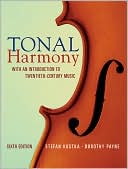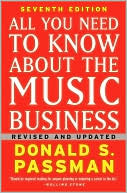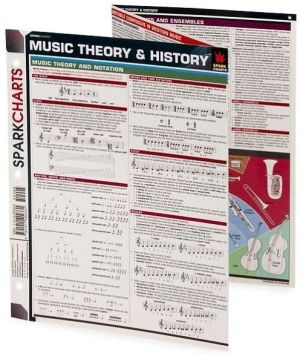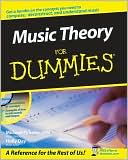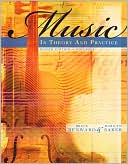Tonal Harmony
Search in google:
For nearly two decades Tonal Harmony has been the leading text for the two-year theory curriculum for music majors. Used at nearly 800 schools, Tonal Harmony has been consistently praised for its practicality and ease of use for student and instructor alike. The straightforward approach is supported by well-chosen examples and thoughtful exercises, and the total presentation is compatible with differing teaching styles and theoretical points of view. In addition, a set outstanding ancillaries, which include a collection of audio examples on CD (for both the text and workbook) and an extensive Instructor's Manual, round out the comprehensive teaching package.
Preface To the Student Part I: Fundamentals Chapter 1: Elements of Pitch The Keyboard and Octave Registers Notation of the Staff The Major Scale The Major Key Signatures Minor Scale Minor Key Signatures Scale Degree Names Intervals Perfect, Major, and Minor Intervals Augmented and Diminished Intervals Inversion of Intervals Consonant and Dissonant Intervals Summary Chapter 2: Elements of Rhythm Rhythm Durational Symbols Beat and Tempo Meter Division of the Beat Simple Time Signatures Compound Time Signatures Time Signatures Summarized More on Durational Symbols Summary Chapter 3: Introduction to Triads and Seventh Chords Introduction Triads Seventh Chords Inversions of Chords Inversion Symbols and Figured Bass Lead Sheet Symbols Recognizing Chords in Various Textures Summary Chapter 4: Diatonic Chords in Major and Minor Keys Introduction The Minor Scale Diatonic Triads in Major Diatonic Triads in Minor Diatonic Seventh Chords in Major Diatonic Seventh Chords in Minor Summary Part II: Diatonic Triads Chapter 5: Principles of Voice Leading Introduction The Melodic Line Notating Chords Voicing a Singe Triad Parallel Motion Summary Chapter 6: Root Position Part Writing Introduction Root Position Part Writing with Repeated Roots Root Position Part Writing with Roots a 4th (5th) Apart Root Position Part Writing with Roots a 3rd (6th) Apart Root Position Part Writing with Roots a 3rd(7th) Apart Instrumental Ranges and Transpositions Summary Chapter 7: Harmonic Progression Introduction Sequences and the Circle of Fifths The I and V Chords The II Chord The VI Chord The III Chord The VII Chord The IV Chord Common Exceptions Differences in the Minor Mode Progressions Involving Seventh Chords Harmonizing a Simple Melody Conclusion Summary Chapter 8: Triads in First Inversion Introduction Bass Arpeggiation Substituted First Inversion Triads Parallel Sixth Chords Part Writing First Inversion Triads Soprano-Bass Counterpoint Summary Chapter 9: Triads in Second Inversion Introduction Bass Arpeggiation and the Melodic Bass The Cadential Six-Four The Passing Six-Four The Pedal Six-Four Part Writing for Second Inversion Triads Summary Chapter 10: Cadences, Phrases, and Periods Musical Form Cadences Cadences and Harmonic Rhythm Motives and Phrases Mozart: “An die Freude” Period Forms Summary Chapter 11: Non Chord Tones 1 Introduction Classification of Non-Chord Tones Passing Tones Neighboring Tones Suspensions and Retardations Figured Bass and Lead Sheet Symbols Embellishing a Simple Texture Summary Chapter 12: Non-Chord Tones 2 Appoggiaturas Escape Tones The Neighbor Group Anticipations The Pedal Point Special Problems in the Analysis of Non-Chord Tones Summary Part III: Diatonic Seventh Chords Chapter 13: The V7 Chord Introduction General Voice-Leading Considerations The V7 in Root Position The V7 in Three Parts Other Resolutions of the V7 The Inverted V7 Chord The V6/5 Chord The V4/3 Chord The V4/2 Chord The Approach to the Seventh Summary Chapter 14: The II7 and VII7 Chords Introduction The II7 Chord The VII7 Chord in Major The VII7 Chord in Minor Summary Chapter 15: Other Diatonic Seventh Chords The IV7 Chord The VI7 Chord The I7 Chord The III7 Chord Seventh Chords and the Circle-of -Fifths Progression Summary Part IV: Chromaticism 1 Chapter 16: Secondary Functions 1 Chromaticism and Altered Chords Secondary Functions Secondary Dominant Chords Spelling Secondary Dominants Recognizing Secondary Dominants Secondary Dominants in Context Summary Chapter 17: Secondary Functions 2 Secondary Leading-Tone Chords Spelling Secondary Leading-Tone Chords Recognizing Secondary Leading-Tone Chords Secondary Leading-Tone Chords in Context Sequences Involving Secondary Functions Deceptive Resolutions of Secondary Functions Other Secondary Functions Summary Chapter 18: Modulations Using Diatonic Common Chords Modulation and Change of Key Modulation and Tonicization Key Relationships Common-Chord Modulation Analyzing Common-Chord Modulation Summary Chapter 19: Some Other Modulatory Techniques Altered Chords as Common Chords Sequential Modulation Modulation by Common Tone Monophonic Modulation Direct Modulation Summary Chapter 20: Binary and Ternary Forms Formal Terminology Binary Forms Ternary Forms Rounded Binary Forms 12-Bar Blues Other Formal Designs Summary Part V: Chromaticism 2 Chapter 21: Mode Mixture Introduction Borrowed Chords in Minor The Use of B-Flat 6 in Major Other Borrowed Chords in Major Modulations Involving Mode Mixture Summary Chapter 22: The Neapolitan Chord Introduction Conventional Use of the Neapolitan Other Uses of the Neapolitan Summary Chapter 23: Augmented Sixth Chords 1 The Interval of the Augmented Sixth The Italian Augmented Sixth Chord The French Augmented Sixth Chord The German Augmented Sixth Chord Other Uses of the Conventional Augmented Sixth Chords Summary Chapter 24: Augmented Sixth Chords 2 Introduction Other Bass Positions Resolutions to Tonic Resolutions to Other Scale Degrees Resolutions to Other Chord Members Other Types of Augmented Sixth Chords Summary Chapter 25: Enharmonic Spellings and Enharmonic Modulations Enharmonic Spellings Enharmonic Interpretation Enharmonic Modulations Using the Major-Minor Seventh Sonority Enharmonic Modulations Using the Diminished Seventh Chord Other Examples of Enharmonicism Summary Chapter 26: Further Elements of the Harmonic Vocabulary Introduction The Dominant with a Substituted 5th The Dominant with a Raised 5th Ninth, Eleventh, and Thirteenth Chords The Common-Tone Diminished Seventh Chord Simultaneities Coloristic Chord Progressions Summary Part VI: Late Romanticism and the Twentieth Century Chapter 27: Tonal Harmony in the Late Nineteenth Century Introduction Counterpoint Treatment of Dominant Harmony Sequence Expanded Tonality Summary Chapter 28: An Introduction to Twentieth-Century Practices Introduction Impressionism Scales Chord Structure Parallelism Pandiatonicism Rhythm and Meter Set Theory The Twelve-Tone Technique Tonal Serialization Aleatory of Chance Music Texture and Expanded Instrumental Resources Electronic Music Summary and Forward Look Appendix A: Instrumental Ranges and Transpositions Appendix B: Answers to Self-Tests Appendix C: Index of Music Examples Name Index Subject Index
